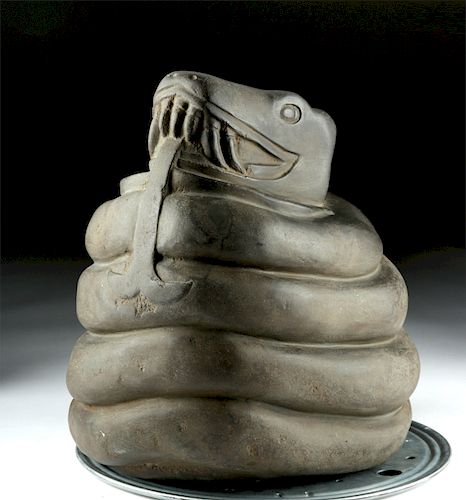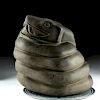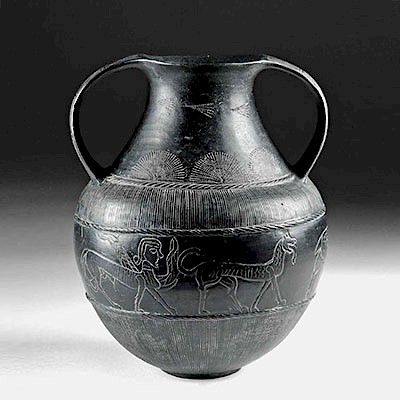Large Aztec Stone Coiled Snake, ex-Stendahl
Lot 188
About Seller
Artemis Gallery
686 S Taylor Ave, Ste 106
Louisville, CO 80027
United States
Selling antiquities, ancient and ethnographic art online since 1993, Artemis Gallery specializes in Classical Antiquities (Egyptian, Greek, Roman, Near Eastern), Asian, Pre-Columbian, African / Tribal / Oceanographic art. Our extensive inventory includes pottery, stone, metal, wood, glass and textil...Read more
Estimate:
$18,000 - $25,000
Absentee vs Live bid
Two ways to bid:
- Leave a max absentee bid and the platform will bid on your behalf up to your maximum bid during the live auction.
- Bid live during the auction and your bids will be submitted real-time to the auctioneer.
Bid Increments
| Price | Bid Increment |
|---|---|
| $0 | $25 |
| $300 | $50 |
| $1,000 | $100 |
| $2,000 | $250 |
| $5,000 | $500 |
| $10,000 | $1,000 |
| $20,000 | $2,500 |
| $50,000 | $5,000 |
| $100,000 | $10,000 |
| $200,000 | $20,000 |
About Auction
By Artemis Gallery
Mar 21, 2019
Set Reminder
2019-03-21 10:00:00
2019-03-21 10:00:00
America/New_York
Bidsquare
Bidsquare : Fine Ancient | Asian | Ethnographic Art
https://www.bidsquare.com/auctions/artemis-gallery/fine-ancient-asian-ethnographic-art-3967
Featuring classical antiquities, ancient and ethnographic art from cultures encompassing the globe, plus fine art. Egyptian, Greek, Roman, Etruscan, Near Eastern, Asian, Pre-Columbian, Native American, African / Tribal, Oceanic, Spanish Colonial, Russian, Fine Art, so much more! Artemis Gallery info@artemisgallery.com
Featuring classical antiquities, ancient and ethnographic art from cultures encompassing the globe, plus fine art. Egyptian, Greek, Roman, Etruscan, Near Eastern, Asian, Pre-Columbian, Native American, African / Tribal, Oceanic, Spanish Colonial, Russian, Fine Art, so much more! Artemis Gallery info@artemisgallery.com
- Lot Description
Pre-Columbian, Central Mexico, Aztec, ca. 1325 to 1475 CE. An expertly carved and quite large volcanic stone sculpture depicting a coiled serpent with an intimidating visage presenting incised beady eyes, an open mouth revealing sharp fangs and a long forked tongue that extends down to the second of the four coils of its body, and a rattler at the end of his body. Snakes/serpents provide a fascinating element of Pre-Columbian iconography, as important symbols of power, rebirth, transition, and renewal. Since snakes shed their skin annually, thus rejuvenating themselves, the ancients of Mexico viewed them as providing hope for the possibility of change in the face of adversity. Size: 13.5" L x 9.5" W x 13" H (34.3 cm x 24.1 cm x 33 cm)
See an example of an Aztec coiled snake stone sculpture at the Metropolitan Museum of Art. The curator's descriptions points to other serpents depicted in ancient Mexican visual culture, "At the Main Temple in the Aztec imperial capital Tenochtitlan, serpent depictions proliferate: monumental snake heads, probably representing different species—with open fanged mouths and forked tongues—flank braziers and stairways leading to the sanctuaries. The temple itself is said to have been surrounded at the time of the Spanish conquest by a serpent wall, or Coatepantli, formed by hundreds of adjoining sculptures of snakes." (https://www.metmuseum.org/art/collection/search/307635)
The serpent form may also be a reference to Quetzalcoatl - "Feathered Serpent" in the Nahuatl language - the Pre-Columbian deity revered as lord of wind and sky. The earliest representations of Quetzalcoatl adorn the Temple of Quetzalcoatl in Teotihuacan, Mexico (ca. 3rd century CE) where numerous stone heads of the divine plumed snake embellish the steps of this Pre-Classic pyramid. The pioneering artist/anthropologist Miguel Covarrubias whose writings and illustrations on indigenous cultures of the ancient Americas continue to contribute to scholarly studies today stated, "Quetzalcoatl stood for all that was good in this world: peace, art, wisdom, and prosperity. Disguised as an ant, he discovered maize, the staple food of the Indians, hidden under the mountain of Substance, Tonacatepetl; he also invented the arts, the sciences, and the calendar. In fact, everything connected with wisdom and culture was attributed to Quetzalcoatl." (Miguel Covarrubias, Mexico South: The Isthmus of Tehuantepec (New York: Alfred A. Knopf, 1946), 130.
A similar Aztec stone sculpture of a coiled serpent is listed for $27,500 by a New York dealer - http://historicaldesign.com/print/?product_id=7639
Provenance: private Southern California, USA collection, purportedly acquired at Stendahl Gallery around 1975
All items legal to buy/sell under U.S. Statute covering cultural patrimony Code 2600, CHAPTER 14, and are guaranteed to be as described or your money back.
A Certificate of Authenticity will accompany all winning bids.
We ship worldwide and handle all shipping in-house for your convenience.
#140956Normal surface wear commensurate with age but in general, intact and excellent.Condition
- Shipping Info
-
All shipping is handled in-house for your convenience. Your invoice from Artemis Gallery will include shipping calculation instructions. If in doubt, please inquire BEFORE bidding for estimated shipping costs for individual items.
-
- Buyer's Premium



 EUR
EUR CAD
CAD AUD
AUD GBP
GBP MXN
MXN HKD
HKD CNY
CNY MYR
MYR SEK
SEK SGD
SGD CHF
CHF THB
THB
















